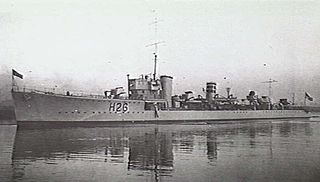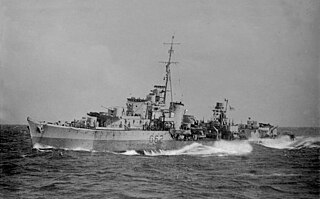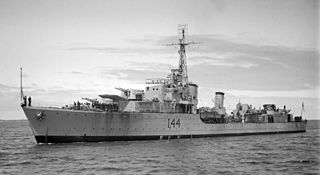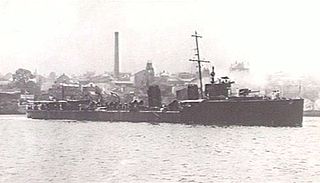
HMAS Bataan (D9/I91/D191) was a Tribal-class destroyer of the Royal Australian Navy (RAN). Laid down in 1942 and commissioned in 1945, the destroyer was originally to be named Chingilli or Kurnai but was renamed prior to launch in honour of the US stand during the Battle of Bataan.

HMAS Quadrant (G11/D11/F01), named for the navigational instrument, was a Q-class destroyer operated by the Royal Navy as HMS Quadrant (G67/D17) during World War II, and the Royal Australian Navy (RAN) from 1945 to 1957. The ship was built during the early 1940s as one of the War Emergency Programme destroyers, and entered service in 1942.

HMAS Quickmatch (G92/D21/D292/F04) was a Q-class destroyer operated by the Royal Australian Navy (RAN). Although commissioned into the RAN in 1942, the ship was initially the property of the Royal Navy. Quickmatch served with both the British Eastern Fleet and British Pacific Fleet during World War II. In the 1950s, the destroyer was converted into an anti-submarine frigate. In 1957, Quickmatch operated in support of Malaya during the Malayan Emergency. The ship remained in service until 1963, and after use as an accommodation ship, was sold for scrap in 1972.

HMAS Swordsman (H11) was an Admiralty S-class destroyer of the Royal Australian Navy (RAN). Built for the Royal Navy during World War I, the ship was not completed until 1919, and was transferred to the RAN at the start of 1920. The destroyer's career was uneventful, with most of it spent moored in Sydney. Swordsman was decommissioned in 1929, and scuttled off Sydney in 1939.

HMAS Tasmania (H25) was an Admiralty S class destroyer of the Royal Australian Navy (RAN). Built for the Royal Navy during World War I, the ship was not completed until 1919, and spent a year commissioned but not operational in British service before being transferred to the RAN at the start of 1920. The destroyer's career was uneventful, with almost all of it spent in Australian waters. Tasmania was decommissioned in 1930, and was sold for ship breaking in 1937.

HMAS Tattoo (H26) was an Admiralty S class destroyer of the Royal Australian Navy (RAN). Built for the Royal Navy during World War I, the ship was not completed until 1919, and spent less than eight months in British service before being transferred to the RAN at the start of 1920. After arriving in Australia, Tattoo spent her entire career in Australian waters, and was placed in reserve on several occasions. Tattoo was decommissioned in 1936, and was sold for ship breaking in 1937.

HMS Quality (G62/D18) was a Q-class destroyer built for the Royal Navy. Entering service in 1942, the destroyer served in several theatres of World War II. Following the war's conclusion, the ship was transferred to the Royal Australian Navy (RAN), commissioning as HMAS Quality (G62/D262) in late 1945. Unlike her sister ships, which were refitted as anti-submarine frigates, Quality was not modified, decommissioned after only 59 days of service, and was sold for scrap in 1958.

HMAS Stuart was a British Scott-class flotilla leader. The ship was built by Hawthorn Leslie and Company for the Royal Navy during World War I, and entered service at the end of 1918. The majority of the destroyer's British service was performed in the Mediterranean, and in 1933 she was transferred to the Royal Australian Navy. Although placed in reserve in 1938, Stuart was reactivated at the start of World War II to lead the Australian destroyer force, nicknamed the "Scrap Iron Flotilla" by German propagandists.

HMAS Anzac was a Parker-class destroyer leader that served in the Royal Navy and the Royal Australian Navy (RAN). Launched in early 1917 and commissioned into the Royal Navy, Anzac led the 14th Destroyer Flotilla of the Grand Fleet during the First World War. In 1919, she and five other destroyers were transferred to the RAN, with Anzac commissioning as an Australian warship in 1920. Except for three visits to New Guinea and one to the Solomon Islands, Anzac remained in southern and eastern Australian waters for her entire career. The destroyer was decommissioned in 1931, sold for scrapping four years later, stripped for parts, then towed outside Sydney Heads and sunk as a target ship in 1936.

HMAS Warramunga (I44/D123) was a Tribal-class destroyer of the Royal Australian Navy (RAN). Built during World War II, the destroyer entered service in late 1942. She was initially assigned to convoy escort duties, but was assigned to the joint Australian-American Task Force 74 in 1943, and was involved in supporting numerous amphibious landings through the South-east Asian region until the end of the war. From 1950 and 1952, Warramunga fought in the Korean War, then was converted into an anti-submarine destroyer. Returning to service in 1954, the destroyer was one of the first RAN ships to operate with the Far East Strategic Reserve, and undertook two tours with the organisation before she was decommissioned in 1959 and sold for ship breaking in 1963.

HMAS Vendetta (D69/I69) was a V-class destroyer that served in the Royal Navy and the Royal Australian Navy (RAN). One of 25 V class ships ordered for the Royal Navy during World War I, Vendetta entered service in 1917.

HMAS Huon (D50), named after the Huon River, was a River-class torpedo-boat destroyer of the Royal Australian Navy (RAN). Originally to be named after the River Derwent, the ship was renamed before her 1914 launch because of a naming conflict with a Royal Navy vessel.

HMAS Waterhen (D22/I22) was a W-class destroyer that served in the Royal Navy and the Royal Australian Navy (RAN). Built during World War I, the destroyer was completed in mid 1918, and commissioned into the Royal Navy. In 1933, Waterhen and four other British ships were transferred to the RAN. The ship's early RAN career was uneventful, with periods spent decommissioned in reserve, but she was reactivated in September 1939, and deployed to the Mediterranean as part of the Australian destroyer force: the Scrap Iron Flotilla. During her time in the Mediterranean, Waterhen was involved in escort and patrol duties, performed shore bombardments, and participated in Allied evacuations from Greece and Crete. On 29 June 1941, while operating with the Tobruk Ferry Service, Waterhen was heavily damaged by Axis aircraft. Attempts to tow the ship to port were unsuccessful, and she sank on 30 June 1941, the first RAN ship lost to combat in World War II.
HMS Phoebe was an Admiralty M-class destroyer built for the Royal Navy during the First World War. She took part in the Zeebrugge Raid in 1918 and was sold for scrap in 1921.

HMAS Stalwart (H14) was an Admiralty S class destroyer of the Royal Australian Navy (RAN). Built for the Royal Navy during World War I, the ship was not completed until 1919, and spent less than eight months in British service before being transferred to the RAN at the start of 1920. The destroyer's career was uneventful, with almost all of it spent operating along the east coast of Australia. Stalwart was decommissioned at the end of 1925, was sold for ship breaking in 1937, then was scuttled in 1939.
HMS Ophelia was an Admiralty M-class destroyer built for the Royal Navy during the First World War, entering service in 1916. The ship served at the Battle of Jutland on 31 May/1 June 1916, and sank a German submarine in 1918. She was sold for scrap in 1921.
HMS Onslow was an Admiralty M-class destroyer built for the Royal Navy during the First World War. She took part in the Battle of Jutland in 1916 and was sold for scrap in 1921.

HMS Scythe was an S-class destroyer built for the Royal Navy during the First World War. She was involved in the Irish Civil War in the interwar period before being sold for scrap in 1931.

HMS Partridge was a Royal Navy Admiralty M-class destroyer constructed and then operational in the First World War, later being sunk by enemy action in 1917. The destroyer was the sixth Royal Navy vessel to carry the name HMS Partridge.
HMS Recruit was a R-class destroyer built for the Royal Navy during the First World War. She was sunk by a German U-boat four months after she was commissioned in April 1917.

















